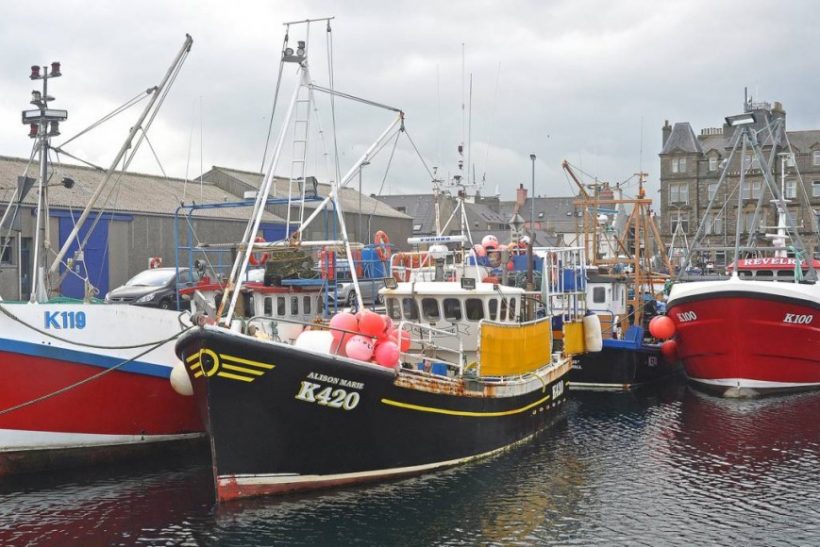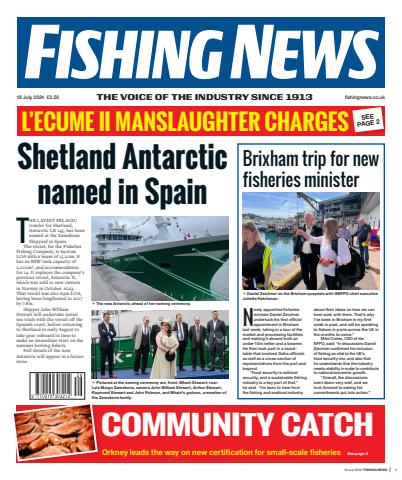A combination of shellfish and whitefish, landed by a mixed fleet of some 60 locally-owned +9m creel boats, scallopers and trawlers, are of vital socio-economic importance to local communities on the Orkney Islands, situated some 40 miles to the north of Scotland across the Pentland Firth. David Linkie reports
Above: Crabbers berthed in Kirkwall harbour.
The 70 or so islands and skerries that make up the Orkney archipelago have over 500 miles of coastline, from which a predominately inshore fleet of static-gear vessels harvest prime quality.
The diversity of locally-owned mobile and static boats fishing prawns, shellfish and whitefish means that Orkney is effectively a microcosm of the Scottish fleet, and therefore is facing similar challenges, including the threat of losing traditional fishing grounds to the twin-pronged threat of MPAs and renewable energy interests, as well as the unknowns relating to the demersal landing obligation.
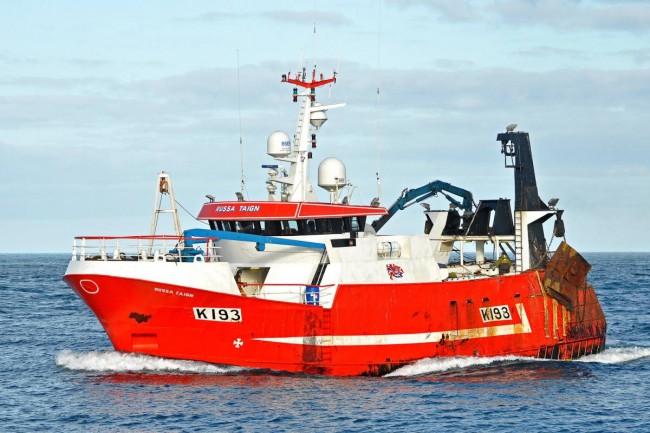
Russa Taign is one of three Orkney-owned whitefish trawlers.
In 2014, the total annual catch value landed into Orkney was nearly £8m. With the exception of a summer handline mackerel catch of £26,000, this total came solely from shellfish, of which brown crab contributed nearly £4m, lobsters £1.5m and velvet crabs £1.3m. These figures provide an initial snapshot of the crucial importance of shellfish in Orkney.
Static-gear effort is fairly evenly spread through the Islands, stretching from Westray to the north, south to Burwick, and from Stromness on the west coast of the mainland across to Kirkwall and east to Sanday.
By necessity, in respect of marketing opportunities, the locally-owned whitefish trawlers have no option other than to land their all catches to markets outwith Orkney.
When demersal catches are taken into consideration, the annual catch value of the Orkney fleet is considerably in excess of £12m.
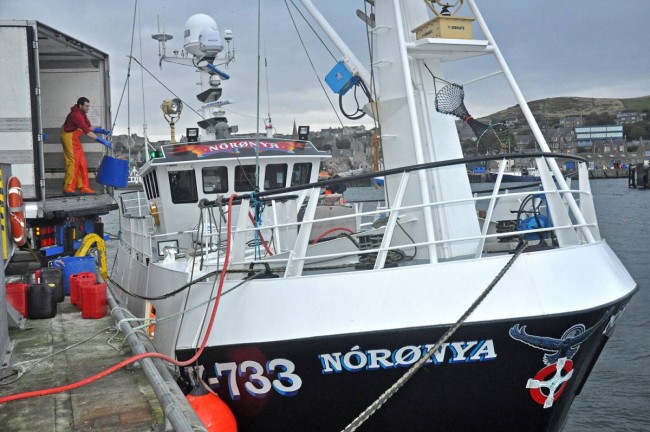
Landing brown crab from Nórønya into a vivier-lorry at Stromness.
To give perspective to this level of achievement, when taken as a single landing centre for locally-owned boats, these figures put Orkney in the top five Scottish ports, and fairly close on the heels of the leading ports in England.
This level of performance emphasises the importance of fishing in Orkney, and the determination of local fishermen to both protect the valuable natural resources in their coastal waters and to continue to invest in the future of their industry.
Fishing News will include a special feature on Westray next week.
Brown crab leads the way in Orkney

Crewman start to land brown crab from a vivier vessel at Stromness.
Accounting for 48% by value and 68% by quantity of annual catches into Orkney, at £3.8m and 2,810t, brown crab are by some considerable margin the single most important species landed in Orkney.
The vital importance of shellfish in Orkney is highlighted by the fact that demersal and pelagic fish accounted for just 1% of the 2014 annual catch value of £7,781,000.
In terms of value, at £1,468,000 lobsters are the second most important species caught by Orkney-based vessels, closely followed by velvet crabs (£1,277,000).
Scallops (£686,000/254t) landed from a combination of dive boats and inshore mobile gear vessels occupy fourth place by value in the annual futurecatch table.
Considerable smaller quantities of green crab, periwinkles, razorfish and whelks make up the balance of shellfish catches.
The developing summer inshore hand-line-caught mackerel fishery saw a relatively small but significant increase in activity in 2014, with a catch value of £25,000, compared to £4k the previous year.
While the two-year trial period for hand-lined mackerel implemented by the Scottish government provides a welcome degree of seasonal diversity and flexibility where none existed previously, Orkney fishermen would like to see longer-term commitment given to this fishery, together with investment in onshore processing and infrastructure required to join the dots between catching and marketing, so that fuller benefit can be secured going forward.
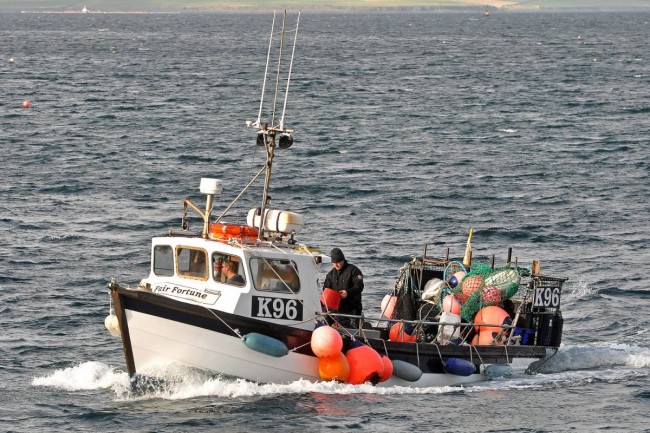
Fair Fortune heading into Kirkwall to land dived scallops.
| Orkney landings by value and tonnage 2014 and 2013 | ||||
| Species | Value 2014 | Tonnage 2014 | Value 2013 | Tonnage 2013 |
| Brown crab | £3,754,000 | 2,810t | £3,237,000 | 2,614t |
| Lobsters | £1,468,000 | 146t | £1,109,000 | 98t |
| Velvet crabs | £1,277,000 | 490t | £1,337,000 | 478t |
| Scallops | £686,000 | 254t | £767,000 | 300t |
| Total shellfish | £7,695,000 | 4,053t | £7,269,000 | 3,808t |
| Total landings | £7,781,000 | 4,113t | £7,312,000 | 3,849t |
Diverse Orkney fleet
The Orkney fleet includes 40 vessels of over 10m LOA, and 85 boats under that same size criteria.
Not surprisingly, given the dominance of shellfish in the annual landing figures for Orkney, creel boats account for the majority of the local fleet.
However, there is considerable variation in the size and type of static gear boats in Orkney. These range from 19m steel-hulled vivier-crabbers like Noronya and the 17m Celtic Dawn II, that work out of Stromness, to traditional clinker-planked inshore creel boats found throughout the islands.
The diverse nature of this fleet is further highlighted by a broad mix of wooden and GRP-hulled boats in the 10m-12m class including Drift Fisher, Shalimar, Shaunette, Silver Wave; GRP semi-displacement mono-hulled and catamarans like Lady K, Samantha Jane, Sea Breeze, and a number of medium-sized vivier vessels, including Alison Marie, Dolly Anne, Kingfisher, Murray V and Queline.
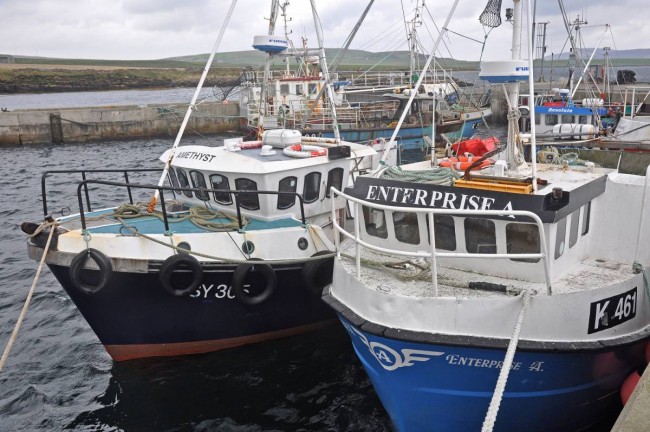
Creel boats berthed in Tingwall harbour.

The creel catamaran Sea Breeze moored at Burwick on South Ronaldsay.

The Westray trawler landing at Scrabster at the end of another Rockall trip.
The last named category also includes the two new additions to Orkney’s crab fleet, Laurie Grieve’s Revelry K 100, a Buccaneer 37 completed three years ago to replace the Cygnus 35 Gowan Star which was sold to Norway, and Scott Norquoy’s Álsviør K 337, a Buccaneer 46 delivered by G Smyth Boats of Kilkeel in 2015.
Shellfish boats are fairly well distributed throughout Orkney. While Kirkwall harbour is probably home to the biggest group of boats on the mainland, significant numbers of creel boats also fish from Tingwall and Stromness. Moving south across the Churchill Barriers, built to protect Royal Navy ships based in Scapa Flow during WWII, shellfish boats are also found at St Margaret’s Hope and Burwick on South Ronaldsay.
Westray, the most northerly of the outlying islands, is home to some 15 creel boats, while east of Orkney, several boats operate from the Sanday and Stronsay.
Orkney’s isolated geographical position, from which all shellfish catches begin their journey to the end consumer – often in European destinations well over 1,000 miles distant – on a ferry across the Pentland Firth, requires creel fishermen to constantly liaise closely with buyers. Several large vivier lorries arrive in Orkney on a Sunday, before they pick up brown crab, lobsters and velvet crabs at various locations.
While the weekly vivier trucks provide a vitally important mobile market, the co-operative-based crab processing factories at Stromness and Pierowall (Westray) also give crucially important market stability, as well as helping to reduce transport costs. Live shellfish storage tanks, in which lobsters are steadily accumulated in the second half of a year before being sold in December, provide further marketing options.
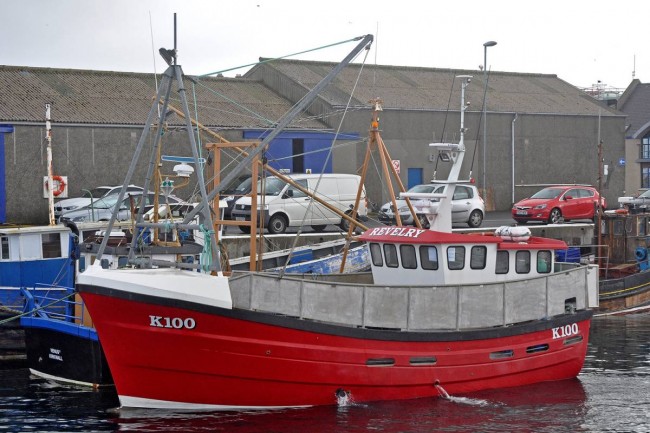
Skipper Laurie Grieve’s Buccaneer 37 Reverly…

… and Scott Norquoy’s Buccaneer 46 Álsviør, are the two newest additions to Orkney’s fleet of medium-sized viver-crabbers.

Sean Denninson’s Queline landing brown crab at Kirkwall to one of the Macneil Shellfish’s viver trucks.
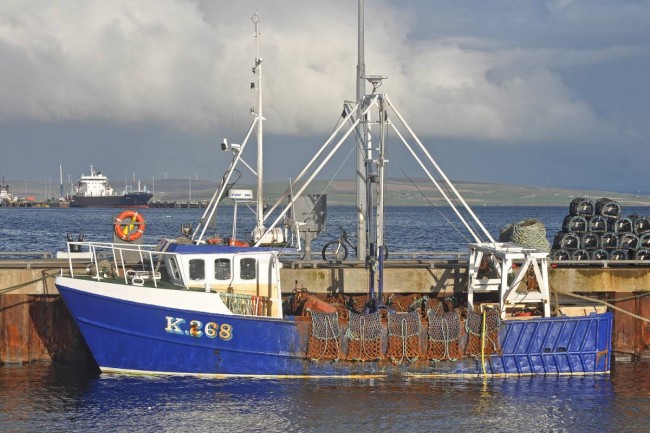
The inshore scalloper Antares berthed at Kirkwall.
A considerably smaller fleet of scallop boats mainly work from Kirkwall, including several dive boats.
Although just two decades ago Orkney, particularly Westray, was home to a strong fleet of modern whitefish trawlers, only three – Aalskere, Keila and Russa Taign – remain today, as largescale quota cuts took a heavy toll.
The absence of any meaningful whitefish process facilities on Orkney mean that these three successful boats, which periodically fish out to Rockall, predominately land into either Scrabster, Peterhead or Lerwick, depending on where they have been fishing.
That Westray skipper Tommy Tulloch has ordered a new 28m single-rig whitefish trawler for delivery by Vestværftet ApS in September 2017 (Fishing News, 21 January) serves as a timely remainder of the determination that fishermen in Orkney – which has seen the arrival of 12 purpose-built new boats in little more than 10 years – continue to exhibit, in order to maintain their proud fishing tradition.
Working to ensure long-term future of traditional shellfish fishing grounds and stocks – Orkney Fishermen’s Association
That every fishing boat in Orkney is locally-owned and managed within the Island community, is one of the key strengths of the industry, and of great importance to its continued forward progression in years to come.
It is understandable therefore that Fiona Matheson, secretary of Orkney Fishermen’s Association, strongly emphasises the importance of ensuring that the current level of viable fishing effort is maintained for future generations.
Fiona Matheson said: “It is imperative that clear focus is given to keeping boats and traditional fishing skills in our Islands-based community. Fishing has long been the bedrock of life in Orkney, as it can be for generations to come.
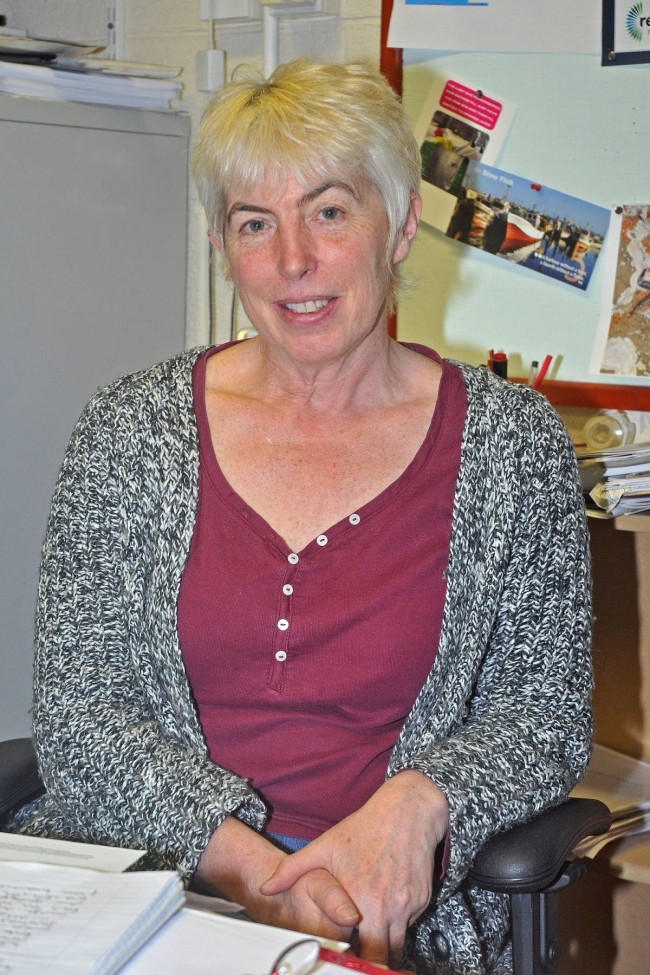
Fiona Matheson – Orkney Fishermen’s Association secretary.
“Just because most of the Orkney fleet are smaller inshore boats, should not be allowed to detract from the vital contribution they bring to small isolated harbours and villages. The level of skills and knowledge local fishermen have is priceless, so it essential that these skills are retained and passed on to the next generation of fishermen.
“Being situated between the Atlantic Ocean and the North Sea gives Orkney a crucially important geographic advantage in the form of a strong north-west/south-east tidal flow. This brings the huge natural benefit of continually carrying in a rich source of feeding from the Atlantic. With the localised tide patterns, this feed regularly flushes across local grounds twice a day, ensuring a constant source of protein and nourishment for all types of seafood.
“This phenomenon, which effectively represents a big sieve, in turn ensures a plentiful food source for the wide variety of prime quality shellfish which account for most of the catches landed into Orkney each year.
“Every effort needs to be made to ensure that this invaluable natural feature continues to bring full benefit to all fishermen and their families in Orkney.
“Although the geographical position of Orkney is beneficial in relation to shellfish feeding, equally this comes at a frequent cost, due to its exposed location, which means that fishermen frequently run up against weather-related difficulties, in addition to the ever-present distance from market, which adds on considerable costs.
“Flexibility is a crucial ingredient in being able to offset this problem to some extent, yet in most regards current legislation is working against this requirement, rather than promoting it.
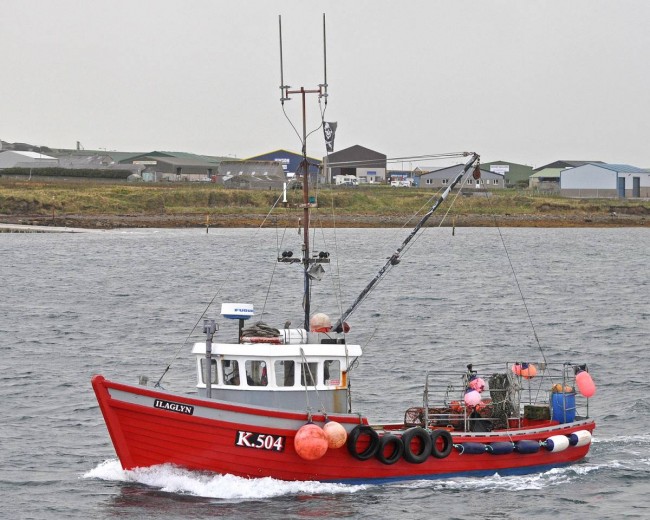
Ilaglyn is one of a number of traditional clinker-planked shellfish boats totally dependant on sustainable long-term access to traditional inshore fishing grounds around Orkney.
“One example of such ‘straight-jacket’ mentality is the non-sector quota system for smaller boats that simply does not work in Orkney, when fishermen are often unable to benefit from quotas held back in summer for the end of the year, when poor weather can wipe out fishing for weeks on end.
“There is little doubt that fishermen today lack protection. Rather than benefitting from positive thinking, aimed at allowing them to sustainably harvest valuable natural and renewable stocks of high value seafood, they are constantly firefighting to protect their right to fish the seabeds that have sustained local communities for generations.
“It is entirely understandable that inshore fishermen fear renewable energy, as well as other spatial development demands, as, slowly but surely, valuable fishing grounds are being lost, as incremental losses steadily creep in, to the detriment of fishermen.
“At a time when fishermen are constantly expected to embrace sustainable fishing practices, who is actually thinking about sustaining fishermen?
“Common-sense must apply before it is too late.
“Orkney fishermen have a highly-prized and much sought-after mixed fishery food resource at their front door, but they need to be allowed to go to sea to harvest it on the same grounds that have yielded reliable and sustainable catches for countless years.”
New regulations to enhance shellfish stocks
Marine Scotland has agreed to increases in MLS proposed by Orkney fishermen, which will be implemented in 2016 to further enhance the quality and sustainability of shellfish stocks in the years to come. Currently, the date of implementation has not been set for the new regulations of:
● New velvet and green crab MLS of 70mm (previously 65mm)
● New lobster MLS of 88mm (previously 87mm), rising to 90mm from 2017
● Ban on landing berried velvets
Orkney fishermen still wish to pursue a higher MLS for scallops of 110mm, increased dredge limits of a maximum of 10, and a bar length restriction inside six miles, to protect seasonal diversity, stock health, and to bring Orkney into line with similar requirements in Shetland.
Caithness Creels widely used by Orkney shellfish fleet
A wide range of bespoke products manufactured by Caithness Creels in Wick are widely used by Orkney static gear fishermen.
High levels of build quality, including durability and fishing performance, are among the reasons why Caithness Creels is popular with fishermen in Orkney, as well as their counterparts throughout the UK.
Shellfish skippers from as far apart as the Channel Islands and Shetland feature strongly in Caithness Creels’ widespread customer base, which is also well represented in Cornwall, Fife, North-East England, Wales and the Western Isles.

Automated welding of a creel frame in progress.
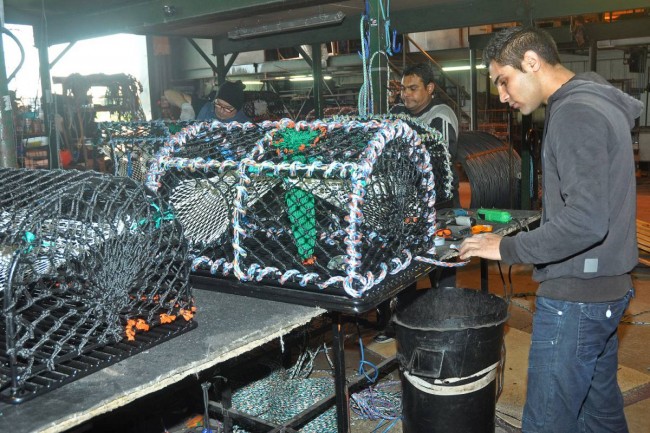
Rigging another creel.

Close-up view of a heavy double 16mm-diameter bar base, designed to prevent leaders moving in deep swell.
Later this year, Caithness Creels will celebrate its 30th anniversary, during which time the company has continued to develop using its well-proven principle of continually working to deliver its customer’s exact requirements.
With 24 full-time employees, Caithness Creels manufactures around 20,000 fully rigged pots per year. Ranging from 24in – 26in creels to 46in parlours, these are delivered to static gear skippers in all areas of Britain, from Shetland south to the Channel Islands, and from Pembrokeshire east to Bridlington.
A wide variety of bespoke size combinations are offered, in line with a skipper’s specific requirements. This includes a new 22in wide parlour creel, introduced in response to requests from skippers, particularly in south-east Scotland and north-east England, for a wider alternative to the 16in, 18in and 20in bases.
Caithness Creels’ ability to offer bespoke products is shown by the fact that they are now manufacturing extremely heavy 26in D-section creels for Celtic Dawn Fishing of Birsay, Orkney, as a result of a specific request.
The 26in x 20in D-section creels feature a double 16mm-diameter bar base in order to give extra weight. Intended to reduce the risk of strings of gear moving considerable distances during periods of heavy North Atlantic swell, two of these creels are fished at each end of a leader, next to the end weights.
Every creel frame manufactured in Caithness Creels’ factory at Wick takes shape in an automated projection welding plant, on which lengths of pre-cut steel rod, for the full flat development structure of each individual frame, are delivered from cartridges into position on the pre-set table jig.
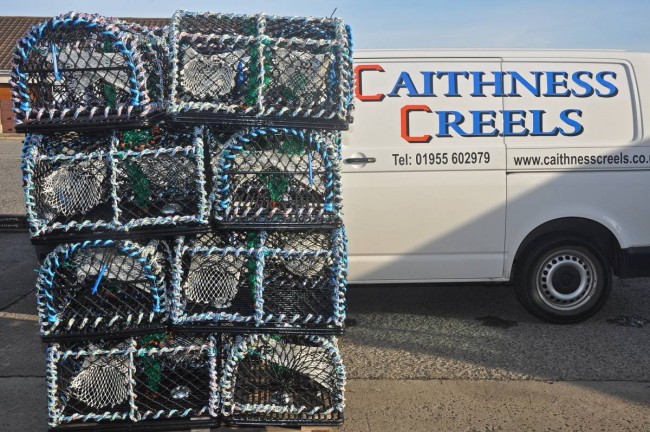
26in crab creels ready for delivery to Orkney.
After being allowed to cool, the flat rectangular assembly is positioned on a hydraulically-operated rolling press, where the traditional D-section is formed, after which the two adjoining surfaces of the base are welded together.
Completed frames are then taken by conveyor through an automated plastic coating plant, before being covered and rigged by highly-skilled long-term workers, every one of which fully completes a creel from the bare frame, thereby ensuring full quality traceability.
Caithness Creels also supplies static-gear skippers with a wide selection of Eurosteel backropes from Euronete, and Polysteel ropes from Mark Slater at Boris Nets, Fleetwood, with whom John Sinclair has done business since establishing the Wick Company in 1986.
Part two of this feature will be coming shortly. Read more from Fishing News here.


A combination of shellfish and whitefish, landed by a mixed fleet of some 60 locally-owned +9m creel boats, scallopers and trawlers, are of vital socio-economic importance to local communities on the Orkney Islands, situated some 40 miles to the north of Scotland across the Pentland Firth. David Linkie reports
Above: Crabbers berthed in Kirkwall harbour.
The 70 or so islands and skerries that make up the Orkney archipelago have over 500 miles of coastline, from which a predominately inshore fleet of static-gear vessels harvest prime quality.
The diversity of locally-owned mobile and static boats fishing prawns, shellfish and whitefish means that Orkney is effectively a microcosm of the Scottish fleet, and therefore is facing similar challenges, including the threat of losing traditional fishing grounds to the twin-pronged threat of MPAs and renewable energy interests, as well as the unknowns relating to the demersal landing obligation.

Russa Taign is one of three Orkney-owned whitefish trawlers.
In 2014, the total annual catch value landed into Orkney was nearly £8m. With the exception of a summer handline mackerel catch of £26,000, this total came solely from shellfish, of which brown crab contributed nearly £4m, lobsters £1.5m and velvet crabs £1.3m. These figures provide an initial snapshot of the crucial importance of shellfish in Orkney.
Static-gear effort is fairly evenly spread through the Islands, stretching from Westray to the north, south to Burwick, and from Stromness on the west coast of the mainland across to Kirkwall and east to Sanday.
By necessity, in respect of marketing opportunities, the locally-owned whitefish trawlers have no option other than to land their all catches to markets outwith Orkney.
When demersal catches are taken into consideration, the annual catch value of the Orkney fleet is considerably in excess of £12m.

Landing brown crab from Nórønya into a vivier-lorry at Stromness.
To give perspective to this level of achievement, when taken as a single landing centre for locally-owned boats, these figures put Orkney in the top five Scottish ports, and fairly close on the heels of the leading ports in England.
This level of performance emphasises the importance of fishing in Orkney, and the determination of local fishermen to both protect the valuable natural resources in their coastal waters and to continue to invest in the future of their industry.
Fishing News will include a special feature on Westray next week.
Brown crab leads the way in Orkney

Crewman start to land brown crab from a vivier vessel at Stromness.
Accounting for 48% by value and 68% by quantity of annual catches into Orkney, at £3.8m and 2,810t, brown crab are by some considerable margin the single most important species landed in Orkney.
The vital importance of shellfish in Orkney is highlighted by the fact that demersal and pelagic fish accounted for just 1% of the 2014 annual catch value of £7,781,000.
In terms of value, at £1,468,000 lobsters are the second most important species caught by Orkney-based vessels, closely followed by velvet crabs (£1,277,000).
Scallops (£686,000/254t) landed from a combination of dive boats and inshore mobile gear vessels occupy fourth place by value in the annual futurecatch table.
Considerable smaller quantities of green crab, periwinkles, razorfish and whelks make up the balance of shellfish catches.
The developing summer inshore hand-line-caught mackerel fishery saw a relatively small but significant increase in activity in 2014, with a catch value of £25,000, compared to £4k the previous year.
While the two-year trial period for hand-lined mackerel implemented by the Scottish government provides a welcome degree of seasonal diversity and flexibility where none existed previously, Orkney fishermen would like to see longer-term commitment given to this fishery, together with investment in onshore processing and infrastructure required to join the dots between catching and marketing, so that fuller benefit can be secured going forward.

Fair Fortune heading into Kirkwall to land dived scallops.
| Orkney landings by value and tonnage 2014 and 2013 | ||||
| Species | Value 2014 | Tonnage 2014 | Value 2013 | Tonnage 2013 |
| Brown crab | £3,754,000 | 2,810t | £3,237,000 | 2,614t |
| Lobsters | £1,468,000 | 146t | £1,109,000 | 98t |
| Velvet crabs | £1,277,000 | 490t | £1,337,000 | 478t |
| Scallops | £686,000 | 254t | £767,000 | 300t |
| Total shellfish | £7,695,000 | 4,053t | £7,269,000 | 3,808t |
| Total landings | £7,781,000 | 4,113t | £7,312,000 | 3,849t |
Diverse Orkney fleet
The Orkney fleet includes 40 vessels of over 10m LOA, and 85 boats under that same size criteria.
Not surprisingly, given the dominance of shellfish in the annual landing figures for Orkney, creel boats account for the majority of the local fleet.
However, there is considerable variation in the size and type of static gear boats in Orkney. These range from 19m steel-hulled vivier-crabbers like Noronya and the 17m Celtic Dawn II, that work out of Stromness, to traditional clinker-planked inshore creel boats found throughout the islands.
The diverse nature of this fleet is further highlighted by a broad mix of wooden and GRP-hulled boats in the 10m-12m class including Drift Fisher, Shalimar, Shaunette, Silver Wave; GRP semi-displacement mono-hulled and catamarans like Lady K, Samantha Jane, Sea Breeze, and a number of medium-sized vivier vessels, including Alison Marie, Dolly Anne, Kingfisher, Murray V and Queline.

Creel boats berthed in Tingwall harbour.

The creel catamaran Sea Breeze moored at Burwick on South Ronaldsay.

The Westray trawler landing at Scrabster at the end of another Rockall trip.
The last named category also includes the two new additions to Orkney’s crab fleet, Laurie Grieve’s Revelry K 100, a Buccaneer 37 completed three years ago to replace the Cygnus 35 Gowan Star which was sold to Norway, and Scott Norquoy’s Álsviør K 337, a Buccaneer 46 delivered by G Smyth Boats of Kilkeel in 2015.
Shellfish boats are fairly well distributed throughout Orkney. While Kirkwall harbour is probably home to the biggest group of boats on the mainland, significant numbers of creel boats also fish from Tingwall and Stromness. Moving south across the Churchill Barriers, built to protect Royal Navy ships based in Scapa Flow during WWII, shellfish boats are also found at St Margaret’s Hope and Burwick on South Ronaldsay.
Westray, the most northerly of the outlying islands, is home to some 15 creel boats, while east of Orkney, several boats operate from the Sanday and Stronsay.
Orkney’s isolated geographical position, from which all shellfish catches begin their journey to the end consumer – often in European destinations well over 1,000 miles distant – on a ferry across the Pentland Firth, requires creel fishermen to constantly liaise closely with buyers. Several large vivier lorries arrive in Orkney on a Sunday, before they pick up brown crab, lobsters and velvet crabs at various locations.
While the weekly vivier trucks provide a vitally important mobile market, the co-operative-based crab processing factories at Stromness and Pierowall (Westray) also give crucially important market stability, as well as helping to reduce transport costs. Live shellfish storage tanks, in which lobsters are steadily accumulated in the second half of a year before being sold in December, provide further marketing options.

Skipper Laurie Grieve’s Buccaneer 37 Reverly…

… and Scott Norquoy’s Buccaneer 46 Álsviør, are the two newest additions to Orkney’s fleet of medium-sized viver-crabbers.

Sean Denninson’s Queline landing brown crab at Kirkwall to one of the Macneil Shellfish’s viver trucks.

The inshore scalloper Antares berthed at Kirkwall.
A considerably smaller fleet of scallop boats mainly work from Kirkwall, including several dive boats.
Although just two decades ago Orkney, particularly Westray, was home to a strong fleet of modern whitefish trawlers, only three – Aalskere, Keila and Russa Taign – remain today, as largescale quota cuts took a heavy toll.
The absence of any meaningful whitefish process facilities on Orkney mean that these three successful boats, which periodically fish out to Rockall, predominately land into either Scrabster, Peterhead or Lerwick, depending on where they have been fishing.
That Westray skipper Tommy Tulloch has ordered a new 28m single-rig whitefish trawler for delivery by Vestværftet ApS in September 2017 (Fishing News, 21 January) serves as a timely remainder of the determination that fishermen in Orkney – which has seen the arrival of 12 purpose-built new boats in little more than 10 years – continue to exhibit, in order to maintain their proud fishing tradition.
Working to ensure long-term future of traditional shellfish fishing grounds and stocks – Orkney Fishermen’s Association
That every fishing boat in Orkney is locally-owned and managed within the Island community, is one of the key strengths of the industry, and of great importance to its continued forward progression in years to come.
It is understandable therefore that Fiona Matheson, secretary of Orkney Fishermen’s Association, strongly emphasises the importance of ensuring that the current level of viable fishing effort is maintained for future generations.
Fiona Matheson said: “It is imperative that clear focus is given to keeping boats and traditional fishing skills in our Islands-based community. Fishing has long been the bedrock of life in Orkney, as it can be for generations to come.

Fiona Matheson – Orkney Fishermen’s Association secretary.
“Just because most of the Orkney fleet are smaller inshore boats, should not be allowed to detract from the vital contribution they bring to small isolated harbours and villages. The level of skills and knowledge local fishermen have is priceless, so it essential that these skills are retained and passed on to the next generation of fishermen.
“Being situated between the Atlantic Ocean and the North Sea gives Orkney a crucially important geographic advantage in the form of a strong north-west/south-east tidal flow. This brings the huge natural benefit of continually carrying in a rich source of feeding from the Atlantic. With the localised tide patterns, this feed regularly flushes across local grounds twice a day, ensuring a constant source of protein and nourishment for all types of seafood.
“This phenomenon, which effectively represents a big sieve, in turn ensures a plentiful food source for the wide variety of prime quality shellfish which account for most of the catches landed into Orkney each year.
“Every effort needs to be made to ensure that this invaluable natural feature continues to bring full benefit to all fishermen and their families in Orkney.
“Although the geographical position of Orkney is beneficial in relation to shellfish feeding, equally this comes at a frequent cost, due to its exposed location, which means that fishermen frequently run up against weather-related difficulties, in addition to the ever-present distance from market, which adds on considerable costs.
“Flexibility is a crucial ingredient in being able to offset this problem to some extent, yet in most regards current legislation is working against this requirement, rather than promoting it.

Ilaglyn is one of a number of traditional clinker-planked shellfish boats totally dependant on sustainable long-term access to traditional inshore fishing grounds around Orkney.
“One example of such ‘straight-jacket’ mentality is the non-sector quota system for smaller boats that simply does not work in Orkney, when fishermen are often unable to benefit from quotas held back in summer for the end of the year, when poor weather can wipe out fishing for weeks on end.
“There is little doubt that fishermen today lack protection. Rather than benefitting from positive thinking, aimed at allowing them to sustainably harvest valuable natural and renewable stocks of high value seafood, they are constantly firefighting to protect their right to fish the seabeds that have sustained local communities for generations.
“It is entirely understandable that inshore fishermen fear renewable energy, as well as other spatial development demands, as, slowly but surely, valuable fishing grounds are being lost, as incremental losses steadily creep in, to the detriment of fishermen.
“At a time when fishermen are constantly expected to embrace sustainable fishing practices, who is actually thinking about sustaining fishermen?
“Common-sense must apply before it is too late.
“Orkney fishermen have a highly-prized and much sought-after mixed fishery food resource at their front door, but they need to be allowed to go to sea to harvest it on the same grounds that have yielded reliable and sustainable catches for countless years.”
New regulations to enhance shellfish stocks
Marine Scotland has agreed to increases in MLS proposed by Orkney fishermen, which will be implemented in 2016 to further enhance the quality and sustainability of shellfish stocks in the years to come. Currently, the date of implementation has not been set for the new regulations of:
● New velvet and green crab MLS of 70mm (previously 65mm)
● New lobster MLS of 88mm (previously 87mm), rising to 90mm from 2017
● Ban on landing berried velvets
Orkney fishermen still wish to pursue a higher MLS for scallops of 110mm, increased dredge limits of a maximum of 10, and a bar length restriction inside six miles, to protect seasonal diversity, stock health, and to bring Orkney into line with similar requirements in Shetland.
Caithness Creels widely used by Orkney shellfish fleet
A wide range of bespoke products manufactured by Caithness Creels in Wick are widely used by Orkney static gear fishermen.
High levels of build quality, including durability and fishing performance, are among the reasons why Caithness Creels is popular with fishermen in Orkney, as well as their counterparts throughout the UK.
Shellfish skippers from as far apart as the Channel Islands and Shetland feature strongly in Caithness Creels’ widespread customer base, which is also well represented in Cornwall, Fife, North-East England, Wales and the Western Isles.

Automated welding of a creel frame in progress.

Rigging another creel.

Close-up view of a heavy double 16mm-diameter bar base, designed to prevent leaders moving in deep swell.
Later this year, Caithness Creels will celebrate its 30th anniversary, during which time the company has continued to develop using its well-proven principle of continually working to deliver its customer’s exact requirements.
With 24 full-time employees, Caithness Creels manufactures around 20,000 fully rigged pots per year. Ranging from 24in – 26in creels to 46in parlours, these are delivered to static gear skippers in all areas of Britain, from Shetland south to the Channel Islands, and from Pembrokeshire east to Bridlington.
A wide variety of bespoke size combinations are offered, in line with a skipper’s specific requirements. This includes a new 22in wide parlour creel, introduced in response to requests from skippers, particularly in south-east Scotland and north-east England, for a wider alternative to the 16in, 18in and 20in bases.
Caithness Creels’ ability to offer bespoke products is shown by the fact that they are now manufacturing extremely heavy 26in D-section creels for Celtic Dawn Fishing of Birsay, Orkney, as a result of a specific request.
The 26in x 20in D-section creels feature a double 16mm-diameter bar base in order to give extra weight. Intended to reduce the risk of strings of gear moving considerable distances during periods of heavy North Atlantic swell, two of these creels are fished at each end of a leader, next to the end weights.
Every creel frame manufactured in Caithness Creels’ factory at Wick takes shape in an automated projection welding plant, on which lengths of pre-cut steel rod, for the full flat development structure of each individual frame, are delivered from cartridges into position on the pre-set table jig.

26in crab creels ready for delivery to Orkney.
After being allowed to cool, the flat rectangular assembly is positioned on a hydraulically-operated rolling press, where the traditional D-section is formed, after which the two adjoining surfaces of the base are welded together.
Completed frames are then taken by conveyor through an automated plastic coating plant, before being covered and rigged by highly-skilled long-term workers, every one of which fully completes a creel from the bare frame, thereby ensuring full quality traceability.
Caithness Creels also supplies static-gear skippers with a wide selection of Eurosteel backropes from Euronete, and Polysteel ropes from Mark Slater at Boris Nets, Fleetwood, with whom John Sinclair has done business since establishing the Wick Company in 1986.
Part two of this feature will be coming shortly. Read more from Fishing News here.

